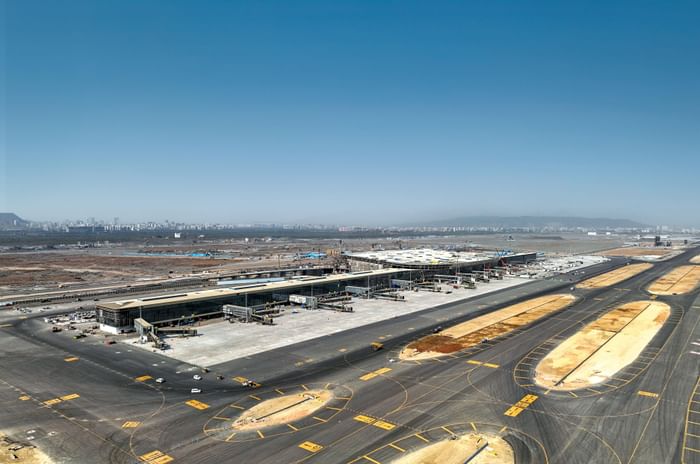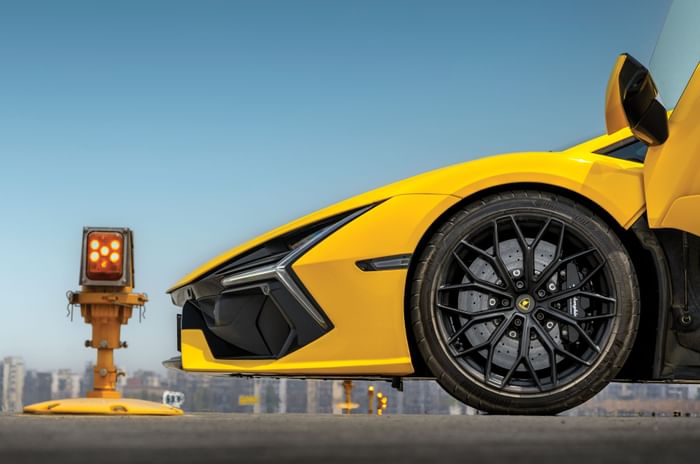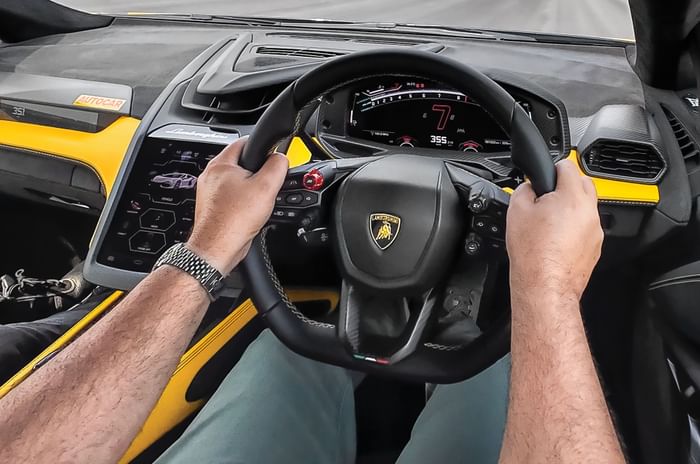Before the first commercial flight takes off from Navi Mumbai International Airport, we give the runway an early shakedown – with four wheels and a V12.
Imagine a place where going slower than 300kph could be dangerous. A stretch of tarmac where speed isn’t optional – it’s essential. This is no ordinary road but a 3.7km-long runway where wide-body jets will routinely land at speeds between 240kph and 290kph. Going slower could mean stalling in mid-air.
Welcome to the Navi Mumbai International Airport, a mega infrastructure project decades in the making and now nearing completion. And what better way to break in this monumental stretch of virgin tarmac than with something equally monumental – the Lamborghini Revuelto.

Why the Revuelto? Simply because it is currently the fastest car on sale in India, and like the Navi Mumbai airport, it’s a celebration of the future.
Besides, Lambos take their inspiration from fighter jets, which is another good reason to choose this air-piercing missile for this epic run.
Lambo’s flagship hypercar is an all-wheel-drive, 1,015hp, plug-in hybrid V12 that combines outrageous performance with bleeding-edge tech. It’s the most powerful Lamborghini ever made, and on a runway designed to handle the world’s largest passenger aircraft – the Airbus A380 – this raging bull has the kind of space it deserves. A space where it can run free.

Revuelto is the perfect car to inaugurate Navi Mumbai Airport’s main runway.
The 6.5-litre V12, augmented by three electric motors – two up front for torque vectoring and one in the gearbox, maximises traction and can catapult the car from 0-100kph in just 2.5 seconds and 200kph in 7 seconds flat. But today, we’re aiming higher. Much higher.
I ‘taxi’ to the edge of the runway in EV mode, the silent all-electric drive of the Revuelto adding to the surreal. I’m in a place where horsepower wears wings, where speed is measured in knots, and where it’s lift – not grip – that rules. This is a rarefied space usually reserved for jets and flight crews, not a lone hypercar, and I have the runway all to myself. I’m not one of 200 passengers stuffed into an economy seat. In fact, it’s a carbon-fibre bucket I’m belted into. Frankly, I can’t believe I am here, but I am, and I’m savouring every heartbeat.

Jet fighter-inspired cockpit makes Revuelto an apt choice for this epic ‘flight’.
The runway lights shimmer in the distance, distorted by the rising heat haze. They’ve been switched on just for me to give the full effect of what it must feel like for a pilot. Red, green, white and amber, these lights aren’t just decoration. Each colour and each placement speaks a coded language to pilots: where to go, when to stop, and when it’s safe to take off. The tall amber lights at the edges mark the runway boundary. They cost an eye-watering Rs 90,000 each, and I’ve been warned. “You hit them, you pay,” says Prabhat Mahapatra, the chief operating officer of Navi Mumbai International Airport Ltd (NMIAL). The economics of aviation run at a different altitude altogether. Here, a crore barely registers. In this world of multi-crore fuel bills, Rs 12 crore for a Revuelto suddenly feels cheap!

Steering clear of the runway lights, which cost Rs 90,000 a pop.
At Navi Mumbai airport, safety dictates everything – and that means no compromises. Everything here is built to global standards, from the precision of the taxiways to the finishing of the terminals. It’s world-class in every sense, the kind of place where pilots and passengers alike could easily believe they’ve landed in Singapore or Frankfurt. And yet, getting here tells a different story. Outside the airport gates, the roads are a patchwork of potholes and half-hearted paving, with haphazard signage that leaves you guessing. But, we are told that better roads and easier access to the airport are being planned. And by the way, it took us just 35 minutes from the Autocar office in Chinchpokli to the airport’s entrance gates!
Lamborghini Revuelto vs Runway
“Autocar 25, you’re cleared for take-off.” Those words crackle over the walkie-talkie, my cue for the ‘pre-flight’ check. Tyre pressures are okay, the Drive mode is turned to Corsa, and the EV system is set to max performance. Launch Control? That’s an absolute no-no because the one thing the NMIAL authorities do not want is strips of rubber laid down on the road! I prod the accelerator a bit, get the Revuelto rolling off the line, and then mash my right foot down hard. We’re off – like we’ve been launched from a catapult. This isn’t a drive. This is a lift-off!

Revuelto’s rear wing is designed for maximum downforce, not lift.
240, 270, 300, the numbers flash by. The car stays arrow-straight, the active rear wing adjusting its angle for maximum downforce – quite the opposite of a plane’s wings, which are designed to generate lift.
The digital speedo flashes 355kph before the soft limiter intervenes as if to say, “Okay, that’s enough for today.” Accounting for speedo error, the true top speed is 350kph. It’s capped not because the Revuelto can’t go faster but because of the limitation of the tyres at higher speeds. The sheer violence with which the Revuelto hits its top speed tells you that without restriction, it could go even faster. Maybe 400? There’s still one gear left! The Revuelto maxes out in seventh gear rather than eighth. That’s because eighth is more of an overdrive, geared for cruising rather than top-end performance. Seventh, with its shorter ratio, is where the V12 has enough torque and revs to push the car to its terminal velocity.

The Revuelto maxes out in seventh gear, with one gear still left.
The Revuelto reaches its top speed in less than 2km, leaving me with 1.7 km to slow down. I could have used another 1km to accelerate if I needed to because the Revuelto’s carbon ceramic brakes, each disc bigger than your dinner plate, haul it down from ludicrous speed with the poise of an aircraft with reverse thrusts on full.
And then, there’s that fabulous-sounding V12. Lamborghini has gone all out to preserve the drama of a naturally aspirated engine, even in this hybrid era. The 6.5-litre V12 still screams to 9,500rpm, its pitch climbing with every rev, getting more maniacal and spine-tingling the closer it gets to redline. It’s not just loud; it’s operatic! Add to it the lightning-quick shifts from the new 8-speed DCT, and the Revuelto’s acceleration becomes not just relentless but also brutal in the best possible way.
On this expansive 45-metre-wide runway, where there’s no traffic, no fear, and nowhere to go but straight, the Revuelto doesn’t just feel fast. It feels… right. That’s because this is a speed that belongs in the sky.
The Revuelto hit a speedo-indicated top speed of 355kph in just 2kms.
And that’s fitting because this is no ordinary strip of asphalt. The runway is Code F-compliant, built to handle aircraft like Boeing 777s and the mammoth Airbus A380, with max takeoff weights of around 560 tonnes. That’s over 400 times heavier than the Revuelto, which today, feels like a feathered dart on an Olympic javelin pitch.
An entire hill was levelled to make this airport happen. Rivers were rerouted. High-tension power lines were shifted. It is infrastructure on a scale few can imagine. And today, before the first jetliner arrives, we’re giving it its maiden run – not with wings but with four tyres and a V12 symphony.

Aircraft boarding staircase came in good use for our camera team.
What strikes you most isn’t just the speed or the violence of acceleration. It’s the serenity. The runway is so perfectly surfaced, so wide, so devoid of distractions that the Revuelto feels eerily at home. It glides. It howls. It slices the air like a jet. In those few moments, you forget it’s a car. You forget you’re on Earth.
Soon, this runway will be home to boarding gates, taxiways and destination boards, and when I take my first commercial flight from here, I’ll smile – because I first flew from here, not in the air, but on the ground. In a Revuelto.
Q&A with Prabhat Mahapatra, COO, NMIL

We’ve driven at 355kph on this runway, but that’s a normal speed for an aircraft to land and take off, isn’t it?
During a takeoff, it’s about 300kph, and while landing, it’s around 240-290kph, depending on the type of aircraft.
Tell us about what went into building this world-class runway.
This runway is built for Code F aircraft like the Airbus A380, and the strength of the runway is based on the expected number of landings per year. Most of this land was hilly, so the surface is extremely hard – absolutely best in class. This runway is equipped with the Instrument Landing System Category II, allowing landings in low visibility up to 350 metres. The runway is 45 metres wide, with 15-metre shoulders on either side and a total length of 3,700 metres, suitable for all aircraft types.
Tell us about the planned second runway and how it will help operations.
 The control tower, which is the heart of airport ops, is nearing completion.
The control tower, which is the heart of airport ops, is nearing completion.
The constraint at CSMIA (Chhatrapati Shivaji Maharaj International Airport) isn’t the terminal capacity; it’s the runway capacity. The two runways intersect, so only one can be used at a time. With NMIAL, the bottleneck at Mumbai will be completely decongested. The North Runway is expected to be commissioned by 2029. So, effectively, there will be three parallel runways in the Mumbai and Navi Mumbai systems, which will greatly enhance capacity. With both our runways operating simultaneously, we’re expecting around 90 to 100 movements per hour.
How is this airport going to be better than CSMIA, the existing Sahar airport?
Land was a constraint in Mumbai, which is why the CSMIA terminal building is curved in shape. In Navi Mumbai, the terminal is linear, enabling us to have more travelators, so passengers don’tneed to walk more than 400 metres. In addition to the immigration counters, we’re heavily investing in digitisation with a Fast Track Trusted Traveller programme, where passengers can check in or out without manual intervention. We’ll be introducing CTX baggage scanning machines in the future.
Digi Yatra will be in place from day one, and we’ll also have a team of data scientists generating a lot of data points, which stakeholders can use to improve airport efficiency. Our focus has been on technology, providing a best-in-class passenger experience, using digitisation to the fullest and prioritising sustainability.

Terminal buildings at NMIAL are getting ready and will have state-of-the-art facilities.
We’re also placing a strong emphasis on sustainability. From the very first day of operations, electric vehicles will be mandatory, and we’ll soon be installing solar power as well. Ultimately, this airport will have the capability to handle 90 million passengers annually.
Tell us about how critical regulations are in setting up an airport.
Our two biggest regulators in India are for safety and security. For safety, it’s the Directorate General of Civil Aviation, and for security, it’s the Bureau of Civil Aviation Security. We must follow every regulation to ensure passenger safety and security. And as the Adani Group, we don’t compromise at all on safety or security.
Also See:
Porsche Cayenne GTS, Panamera GTS on a race track: Fast family fun

